Introduction
Press-Fit technology provides an inherently reliable, solder-free, lead-free and automation-friendly approach that delivers both the high-current capabilities and design flexibility needed for a wide range of applications across a multitude of industries.
In recent years, Press-Fit has gained momentum for enabling new designs that exhibit very consistent performance and higher reliability than traditional solder joints, prompting its increasing adoption amongst manufacturers.
In this post, we’ll help you understand:
- What is Press-Fit technology
- The advantages of Press-Fit technology
- Real world Press-Fit applications
- Key considerations when converting to Press-Fit
We’ll guide you on what to look out for in a Press-Fit specialist, as well as highlight Interplex’s track record in this area.
Ready to get started? Let’s jump in.
Press-Fit Technology
In engineering terms, a press fit— also known as an interference fit— is the fastening of two parts that is achieved by normal force, friction and cold welding. This happens when a shaft is inserted tightly into a slightly smaller hole in another part, with the interference holding both parts in place.
Today, Press-Fit technology is widely used in the manufacturing of electronic and electro-mechanical components. With Press-Fit technology, manufacturers are enabled to create highly reliable electro-mechanical interconnects without the use of solder. This is achieved through the insertion of a specially-stamped terminal into a plated through hole (PTH) of a printed circuit board (PCB).
Let’s take a look at this technology in depth.
A Closer Look
Press-Fit interconnects function like the ubiquitous blade and socket pair in a connector, except the genders are reversed.
In a traditional blade and socket pair, the socket has flexible beams that provide the necessary normal force for an electrical connection, and the blade is rigid. Conversely, in a Press-Fit joint, the Press-Fit pin is the “blade” that has the flexible beams, and the PTH is the “socket”, which remains rigid.
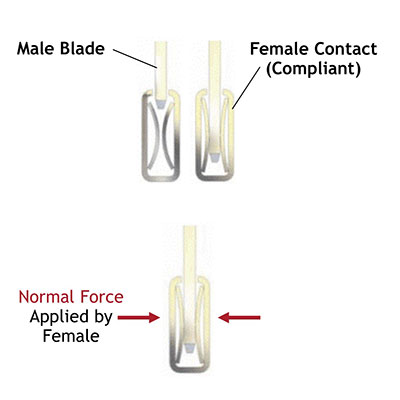
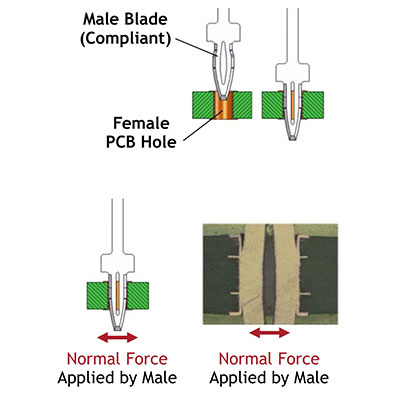
The normal force in a Press-Fit joint is the force exerted on the walls of the PCB hole by the spring characteristic of the Press-Fit pin. Insertion force is the force exerted back against the pin when inserted into the PCB.
While the Press-Fit joint and its blade and socket cousin both employ a pressure connection, the similarity ends there. The blade and socket is intended to be mated and unmated numerous times, so it is designed with lower normal forces (so they mate easily), as well as a surrounding insulated housing that, amongst other things, ensures that the connection stays intact during use.
On the other hand, Press-Fit joints are meant for more permanent connections, and need to reliably make both electrical and mechanical connections without the aid of a housing. Consequently, its normal forces are much higher.
Advantages of Press-Fit Technology
Deployments of Press-Fit eye-of-the-needle style interconnects have shown a consistent pattern of better reliability than similar designs using conventional solder joint connections. This confirms the extensive testing data that has also been amassed in laboratory and production environments, which demonstrate the overall higher quality and reliability of Press-Fit technology compared to solder-based approaches.
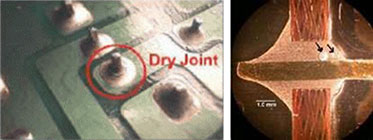
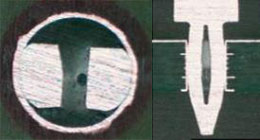
As there is no metal filler, there are no risks of voids or other flaws, thus providing a much higher yield of good interconnections. The solder-free nature of Press-Fit also helps to eliminate any unnecessary heating of assemblies that have been partially or fully populated, thereby avoiding the risk of damage to components and/or the unintended partial reflow of other solder joints that could be weakened by multiple heating cycles.
These key advantages have made Press-Fit technology a preferred solution for the design of many new products. It has also prompted a growing number of design upgrades of products being migrated from solder-based connections to Press-Fit technology.
Some key driving factors towards the growing adoption of Press-Fit include:
- Eliminates risk of dry joints, cracking and other solder formation problems
- Strong, solder-free, repeatable and highly reliable interfaces
- Verifiable assembly techniques with integrated force-monitoring
- Automated Press-Fit assembly processes for consistent results
- Direct-contact interfaces with high normal force
- Excellent electrical and thermal transfer characteristics
- Ability to withstand Coefficient of Thermal Expansion mismatch forces during thermal cycling
- High current-carrying capacity for power applications
Applications of Press-Fit Technology
Press-Fit interconnects can be adapted to support a wide range of application requirements such as PCB-to-PCB stacking interconnects, fuse holders, molded modules, smart junction boxes, controllers, lighting and a variety of other custom applications.
In particular, the explosive growth of automotive, energy and other markets using inverter and converter based power modules is driving the need for Press-Fit technologies to provide reliable, solderless interconnect solutions that can support high current levels.
Today’s Press-Fit interconnects have been tested and proven to support current capacities of 30A or more through a single Press-Fit eye, with reliable, predictable current-carrying performance curves across a range of temperatures including 125ºC to 150ºC and above.
The combination of high-current capacity, high reliability and a wide range of configuration alternatives makes Press-Fit a predominant interconnect design choice for power-oriented applications. The elimination of solder-related hassles while simultaneously improving reliability, performance and reducing production costs offer compelling reasons for the usage of Press-Fit technology.
For example, shown below is a busbar interconnect that leverages a custom-stamped Press-Fit configuration to provide a solderless, high-current, multi-point interface that greatly streamlines the assembly process while improving performance.
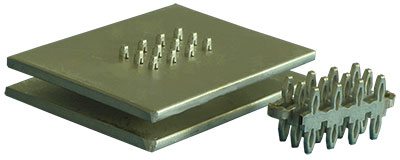
Converting to Press-Fit Technology
Press-Fit interconnects have already proven to be very effective for implementing a wide range of applications that benefit from the ability to provide robust solderless interconnects while streamlining assembly processes.
The configurability of Press-Fit technology also makes it a straightforward process to upgrade from solder-based interconnects as part of most routine product update processes. By incorporating a change to Press-Fit during product updates, manufacturers can boost reliability and reduce costs for the remainder of the product lifecycle.
As more manufacturers look at converting existing designs to use Press-Fit during update or retrofit change cycles, some key factors that come into play include:
- Are changes or updates planned that could open opportunities for retrofit?
- Are secondary solder processes hurting product yields?
- What has been the field quality and reliability experience?
- Is the product exposed to temperature cycling and other environmental stresses?
- Are solder joint failures a cause of field quality problems?
- Can the product benefit from cost reduction over the remaining life-cycle?
Key Considerations for Successful Conversion
Once a decision is made to upgrade a design to use Press-Fit technology, it is a relatively straightforward process, given the maturity of Press-Fit technology and inherent design flexibility. The benefits of conversion almost always outweigh the challenges because Press-Fit rarely necessitates any changes to the core design of the product. However, it is important to point out a few key considerations that should be taken into account to ensure successful conversion. These include factors such as:
- PCB hole size and plating control
- Press-Fit pin lengths
- Press-Fit assembly forces
It is also important to note that Press-Fit technology has now moved beyond just a focus on compliant pins. Today, it has become an important enabling technology for fueling innovation and an expanding range of new product opportunities, as well as cost-savings and quality improvements for existing designs.
As such, it is important to consider the possibilities for leveraging the benefits of Press-Fit from the initial product concept whenever possible. This enables designers and Press-Fit specialists to collaborate from the outset in order to optimize functionality, cost, production efficiency, product reliability and overall profitability.
For an in depth review of the key factors associated with a successful conversion, refer to our Technical Bulletin: Upgrading Product Designs from Solder Joints to Press-Fit – Why, When and How?
What to Look For in a Press-Fit Specialist
Press-Fit technology has matured into a powerful solution for eliminating solder, avoiding complex secondary production processes, improving reliability and reducing costs. However Press-Fit components are not commodity products that can simply be bought off the shelf.
Key elements that must be addressed by Press-Fit interconnect specialists include the following:
- Design and testing standards
- Documentation and applications support
- Raw materials selection and plating process controls
- Global tooling standards, inspection criteria and production control plans
- Worldwide functional testing and application support capabilities
To achieve optimal results, customers should turn to knowledgeable Press-Fit specialists with rigorous design, testing, documentation and production processes.
For an in depth review of what to look out for when selecting a Press-Fit specialist, refer to our Technical Bulletins: Supplier Best-Practices for Getting Results with Press-Fit Technology Part 1 and Part 2.
Our Press-Fit Capabilities
A global leader in solderless Press-Fit Technology, Interplex has been producing Press-Fits over the past decade and is recognized as a global innovator in adapting Press-Fit technology for a wide range of industry-specific applications. Our design, applications engineering and manufacturing expertise integrates our Press-Fit technology into insert molded assemblies typically found in electronic packaging and connector technology.
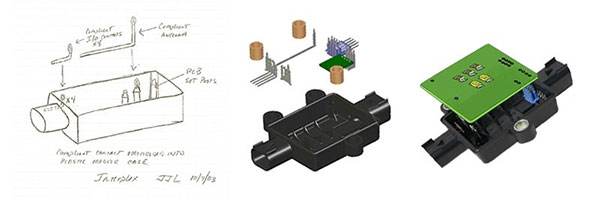
Looking for a Quick Summary?
Check out our video recap of this post:




